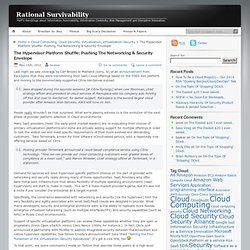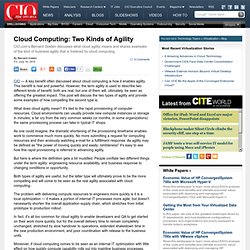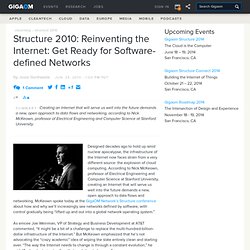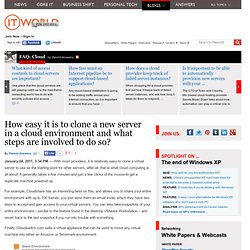

Jurisdictions.
Linked. The Hypervisor Platform Shuffle: Pushing The Networking & Security Envelope. Last night we saw coverage by Carl Brooks Jo Maitland (sorry, Jo) of an announcement from RackSpace that they were transitioning their IaaS Cloud offerings based on the FOSS Xen platform and moving to the commercially-supported Citrix XenServer instead: Jaws dropped during the keynote sessions [at Citrix Synergy] when Lew Moorman, chief strategy officer and president of cloud services at Rackspace said his company was moving off Xen and over to XenServer, for better support.

Rackspace is the second largest cloud provider after Amazon Web Services. AWS still runs on Xen. People really shouldn’t be that surprised. What we’re playing witness to is the evolution of the next phase of provider platform selection in Cloud environments. 11 Top Open-source Resources for Cloud Computing. Digg Open-source software has been on the rise at many businesses during the extended economic downturn, and one of the areas where it is starting to offer companies a lot of flexibility and cost savings is in cloud computing.

Cloud deployments can save money, free businesses from vendor lock-ins that could really sting over time, and offer flexible ways to combine public and private applications. The following are 11 top open-source cloud applications, services, educational resources, support options, general items of interest, and more. Eucalyptus. Ostatic broke the news about UC Santa Barbara’s open-source cloud project last year. Released as an open-source (under a FreeBSD-style license) infrastructure for cloud computing on clusters that duplicates the functionality of Amazon’s EC2, Eucalyptus directly uses the Amazon command-line tools. Red Hat’s Cloud. Traffic Server. Cloudera. Puppet. Jolicloud.
Cloud Computing: Two Kinds of Agility - CIO.com - Business Technology Leadership. CIO — A key benefit often discussed about cloud computing is how it enables agility.

This benefit is real and powerful. However, the term agility is used to describe two different kinds of benefit; both are real, but one of them will, ultimately, be seen as offering the greatest impact. This post will discuss the two types of agility and provide some examples of how compelling the second type is. What does cloud agility mean? It's tied to the rapid provisioning of computer resources. As one could imagine, the dramatic shortening of the provisioning timeframe enables work to commence much more quickly. But here is where the definition gets a bit muddled. Both types of agility are useful, but the latter type will ultimately prove to be the more compelling and will come to be seen as the real agility associated with cloud computing.
With BitTorrent, Twitter Servers Are Moving Data 75x Faster. Structure 2010: Reinventing the Internet: Get Ready for Software. Designed decades ago to hold up amid nuclear apocalypse, the infrastructure of the Internet now faces strain from a very different source: the explosion of cloud computing.

According to Nick McKeown, professor of Electrical Engineering and Computer Science at Stanford University, creating an Internet that will serve us well into the future demands a new, open approach to data flows and networking. McKeown spoke today at the GigaOM Network’s Structure conference about how and why we’ll increasingly see networks defined by software, with control gradually being “lifted up and out into a global network operating system.” As emcee Joe Weinman, VP of Strategy and Business Development at AT&T commented, “It might be a bit of a challenge to replace the multi-hundred-billion-dollar infrastructure of the Internet.” But McKeown emphasized that he’s not advocating the “crazy academic” idea of wiping the slate entirely clean and starting over. Cloud Computing: Whose Crystal Ball is Correct? - CIO.com - Business Technology Leadership.
CIO — Last week brought a spate of interesting—and contradictory—stories and research reports about how enterprises are or will embrace cloud computing, topped off by a report by Forrester analyst James Staten that concludes that for all the talk about private clouds, they're a pipe dream for all but a few enterprises.

Kicking off the parade of news was a survey sponsored by Savvis. The survey asked 600 IT and business decision makers about their plans for cloud computing. Rackspace Shares Its CDN Love With Akamai: Cloud Computing News « How easy it is to clone a new server in a cloud environment and what steps are involved to do so? January 04, 2011, 3:34 PM — With most providers, it is relatively easy to clone a virtual server to use as the starting point for other servers, after all, that is what cloud computing is all about.

It generally takes a few minutes and just a few clicks of the mouse to get a duplicate machine powered up. For example, Cloudshare has an interesting twist on this, and allows you to share your entire environment with up to 100 friends, you just send them an email invite, which they have two days to accept and gain access to your virtual servers. You can also take snapshots of your entire environment – similar to the feature found in the desktop VMware Workstation – and revert back to the last snapshot if you run into trouble with something. Finally, Cloudswitch.com sells a virtual appliance that can be used to move any virtual machine into either an Amazon or Terremark environment. ITworld contributor, David Strom, provided the response to this question. Xangati. Code to Cloud in Minutes. OpSource Cloud - Products - Comparison.